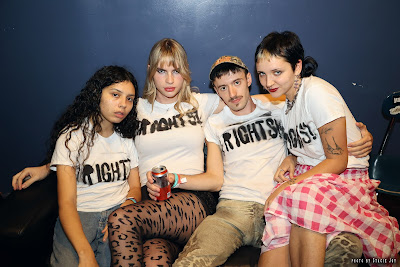Photos by Stacie Joy; Q&A by EVG
Jim Andralis is an East Village-based singer-songwriter ... and trauma-focused psychotherapist in private practice — a unique combination for a unique talent.
His body of work, starting with 2016's debut, "Your Dying Wish Came True," shows Andralis as a pop craftsman, a songwriter of rare melodic gifts. Live, he has been joined by Julie Delano, Lesia Graves, Susan Hwang and Jessie Kilguss — not to mention his husband, artist-designer Larry Krone. (They opened for Bikini Kill on July 9 at Irving Plaza.)
Next Thursday (Aug. 11), Andralis plays at Rockwood Music Hall on Allen Street (it's also his birthday). His proceeds will go to the Yellowhammer Fund, which promotes reproductive justice in Alabama and the Deep South
Ahead of the show, we stopped by Andralis' East Village apartment, where we took a lot of photos of Dory, who graces the cover of his forthcoming LP, "I Can't Stop Trying," and the album's promo T-shirts.
Here, Andralis talks about his career ambitions, life-changing accordion lessons and love of the East Village.
What was your earliest career ambition?
You can keep tabs on Andralis via his website or Instagram.
I had jobs since I was 15 but nothing resembling career ambition until I was well into my 20s. Until then, I think my sole ambition was trying to pass as heterosexual.
Once I moved here at 24, the dream became performing on some kind of stage — ideally singing. The shows I loved the best were Kiki and Herb, The Talent Family (Amy and David Sedaris) plays, Jeff Weiss and Carlos Martinez’s insane serialized stuff.
The people I looked up to the most were hustling in some kind of service-industry job while attempting to carve out some kind of creative life. Imagining I could do that here felt pretty fucking ambitious.
When did music come into the picture?
I had been in a couple off-off Broadway musicals and stuff, but in the early 2000s, I started taking accordion lessons with Walter Kuhr at Main Squeeze Accordions on Essex Street. I’d always been really drawn to the accordion, particularly in the context of a band. But it’s also completely self-contained. You can play the accordion in your apartment, sing along and you can do just do that right away. Playing chords is really easy.
Anyway, you can draw a direct line from accordion lessons with Walter to everything I love about my life here. I was tending bar at Phoenix on 13th and A. Two of my favorite bar customers, Ben and Clint, found out I was taking accordion lessons and asked me if I wanted to be in their band the Isotoners. I started really writing and singing songs in that band. Bridget Everett would usually sing a couple songs with us whenever we performed, so that’s when Bridget and I got to be friends.
Also, the whole reason I met my husband Larry Krone is that he asked me to play accordion with him at one of Julian Fleisher’s nights at Starlite Lounge on Avenue A. So music coming into the picture also coincided with love and family coming into the picture.
You work as a trauma-focused psychotherapist. Do you consider your music to be more of a side project or perhaps a second career?
It’s definitely a whole second career. But it’s not, to be clear, two actual revenue streams. It’s more like, “You want a vinyl pressing for this release? Take on two more clients, motherfucker.”
You're a longtime East Village resident. What first prompted you to move here? What keeps you here?
Long before I actually lived in this neighborhood, I worked and spent every minute I could here. It wasn’t until I first entered The Bar on 2nd and 4th in, like, 1994 that I felt like I could be myself in any kind of gay context. Soon after that, I
started tending bar there, then Gold Bar, Dick’s and finally Phoenix. But I mostly lived in Queens.
When I started dating Larry in 2004 I put in an application for a place in the HDFC where he was already living. I was able to move here (and actually afford it) in 2007, all thanks to our HDFC!
This neighborhood has felt like home to me for way before I lived here. I just feel lucky to miraculously have an apartment here, friends nearby, tons of live music within a 5-10 minute walk.
In conclusion, I believe I shall remain here as long as possible!
I try to live in the moment as much as I can. But I've always been a nostalgic person. Do you find yourself being more nostalgic about the East Village and NYC, in general, these days, or can you balance the present and past to a healthy degree?
It depends on the moment. Some days I walk around and feel the history of our neighborhood existing in this weird, beautiful harmony right alongside the present. Like I’m part of something complicated and beautiful that extends beyond me in all these different dimensions.
Other days, it’s almost like panic because I can’t remember what used to be where this nail place is. Was Little Rickie on First or A? And if I can’t remember fill-in-the-blank, how the hell will anyone remember I was ever here?
It feels very linked to my feelings about mortality. In other words, yes completely healthy!
Sometimes, though, it’s a really sweet nostalgia, like you could get a goddamn soy patty platter at Dojo for 5 bucks in my day, honey!
Tell us more about the recently released single "New York City Spring" and what was going on when you wrote it.
I got COVID pretty bad in March 2020 when the city was just hit so hard.
I don’t think "Working Girl" is the BEST movie, but I like it. It came on TV when I was really sick. I watched the opening with Carly Simon singing, and a million people taking the Staten Island ferry to go work with, like, the Twin Towers on the horizon and I lost my SHIT. It was like this enormous wave of grief and terror came over me, this awareness of how vulnerable this little island is and how much it’s been through.
I write a lot of songs about New York, and I love art that loves New York and New Yorkers, like my friend Neil Goldberg’s gorgeous work. “New York City Spring” is my experience of New York in 2020, when it felt like a scared, wounded place where all these things used to happen. But it ends up kind of a pep talk for us
both and an attempt to conjure some sort of magic to come save us.
You and the band opened for Bikini Kill on July 9 at Irving Plaza. Most memorable moment of the evening for you?
The entire feeling just felt like this enormous, insanely fun moment. We were just ecstatic to have been invited by Bikini Kill to do it and so overwhelmed by how welcoming the venue and crowd were.
But if I had to pick one particular moment, it was being with my band just ecstatically dancing during Bikini Kill’s incredible set. We’d already done our set, loved every second of it, and just got to celebrate the whole thing together as friends while watching the most amazing Bikini Kill show. Plus Kathleen dedicated “For Tammy Rae” to me and Lar. That also felt like heaven and made me cry.
Your birthday is Aug. 11. (Happy early birthday!) You're playing a show that night at Rockwood Music Hall, and you're donating everything you make to the Yellowhammer Fund. Can you tell people more about them and why you support the organization?
The Yellowhammer Fund is doing amazing reproductive justice work helping people in the places being hit the hardest right now. They help marginalized communities get health care. One way I can help is by supporting organizations like Yellowhammer. I’m just grateful they exist. They are doing beautiful work that is saving lives, and also fucking dangerous.
And thanks for the birthday wishes!
Your LP, "I Can't Stop Trying," is due out in early January. Will there be a tour with it? Any special plans?
I mean, I hope so! I’m proud of this record. My friend, producer and engineer Tom Beaujour set up this insanely safe and quarantined recording experience, and making this record really helped me survive that year.
In terms of plans, we usually do a record release at Joe’s Pub. That’s not locked in, but we have our fingers crossed.
I have never toured. I’m dying to do it but can’t quite afford it. But it’s something I feel like I’ll make happen if not for this record definitely the next one, which we’ll be recording this fall!
Larry and I are doing a show in Andes with Julian Fleisher, Neal Medlyn and Julie DeLano on Aug. 6. Can we call that a tour??
























































